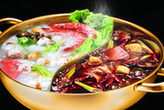Qing emperors took great interest in curio box, not only because of the valuable curios, but also the ingenious design of the box. After accurately calculating the cubage, craftsmen make full use of the inner space of the box and block it into different bays to fit every curio. No one can imagine the rich content of a curio box from its outward appearance alone.
Take the Bamboo-veneered curio box with lotuses for example. This round curio box has been joined by bamboo thread and bamboo veneers, carved with lotuses, applied to the outer surface. The ingenious design allows for the four fan-shaped quadrants of the body to be either spread out so they stand end to end in a straight line, or for them to be turned around 360 degrees so they form a square display. Each quadrant is divided into a number of compartments, one of which has a rotating stand with more sections.
Square sandalwood curio boxQianlong Reign (1736-1795), Qing Dynasty (1644-1911)Length: 25 cm, width: 25 cm, height: 21 cm |
The square sandalwood curio box, which holds 30 curios, is another curio box kept at the National Palace Museum. When closed, the box looks like a plain container. The advantage to this type of box is it does not take up much space in storage. Although the outside appears quite simple, it is by no means monotonous. Its diversity lies in the decorative method of using “panels” by the artisans who made it. On one hand, they allow the viewer to appreciate both painting and calligraphy. On the other hand, they pique one’s curiosity to find out what lies inside. Not letting the viewer down, the wings of the panels can be pulled out one by one to form a fan-shaped chest. Combined with the center that can be turned, it looks almost like a windmill about to spin.
The design of curio box is so complex that some of the gears hide below the curios. Some ingeniously designed curio boxes even let viewers know or see the curio in a drawer or behind a clapboard, but users cannot get the curio unless they see through the trick.
Square sandalwood curio box |
Another characteristic of the curio box from Qing court is the different pleasures in appreciating it before and after taking up curios. Generally, the inner bottom of a box is blank after taking away the things in it, but the curio box is an exception. Take the square sandalwood curio box with cloud-and-dragon patterns for example. After removing the jade wares in the top tray, one will be surprised to find the calligraphy of Yu Minzhong (an official in the Emperor Qianlong’s court who was an expert in handwriting), and the painting of Yang Dazhang. These calligraphies and paintings are still bright and colorful after centuries of erosion.





Why not rent a boyfriend, or girlfriend to please parents during the Spring Festival?